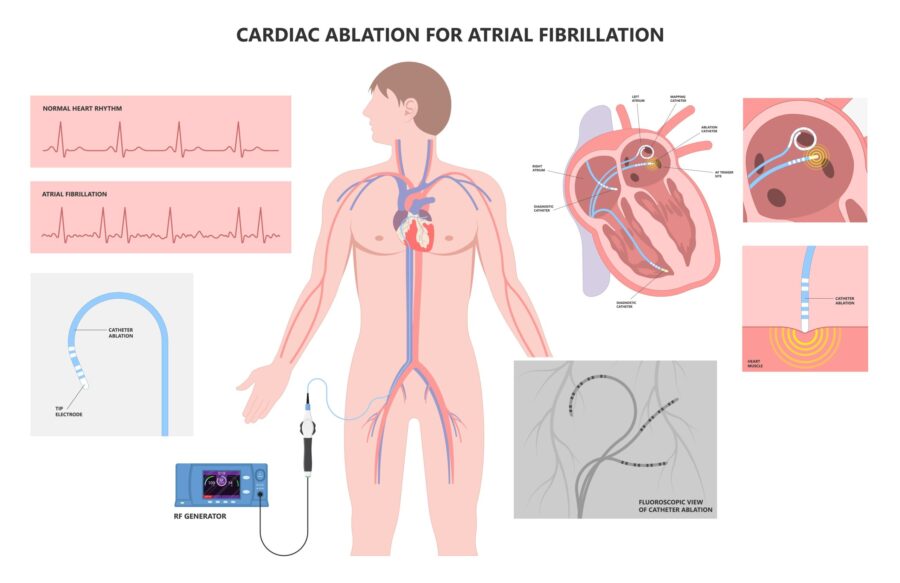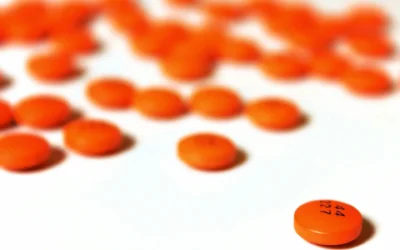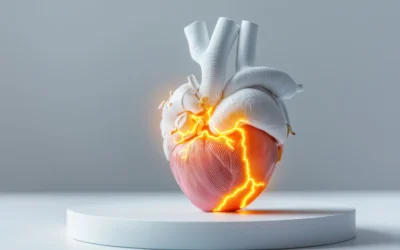Cardiac ablation is a procedure that aims to correct heart rhythm problems. It involves the use of catheters — long, flexible tubes — that are inserted through a blood vessel and guided to your heart. The catheters send energy to the heart tissue causing the abnormal rhythm, creating small scars that prevent these areas from conducting electrical signals. This procedure is typically guided by imaging techniques, providing doctors with real-time images of the heart and catheters during the procedure. The type of energy used can be in the form of heat (radiofrequency energy) or extreme cold (cryoablation).
Types of Cardiac Ablation
Depending on the type of arrhythmia and its location in the heart, different types of ablation may be recommended:
Radiofrequency Ablation (RFA): This is the most common type of ablation, which uses radiofrequency energy to produce heat to destroy problematic heart tissue.
Cryoablation: This method uses very cold temperatures to freeze and disable the heart cells causing arrhythmia.
Why Doctors Recommend Cardiac Ablation
Cardiac ablation is commonly recommended for patients who:
- Have arrhythmias that do not respond well to medications.
- Have a high risk of complications from arrhythmias.
- Prefer it to long-term medication, after discussing it with their doctor.
- Have specific types of arrhythmias like atrial fibrillation, atrial flutter, supraventricular tachycardia, or ventricular tachycardia.
Benefits of Cardiac Ablation
Despite the potential risks, the benefits of cardiac ablation often outweigh the possible complications, especially for those with severe arrhythmias. The benefits can include:
- Symptom relief: For many patients, cardiac ablation helps to significantly reduce or completely eliminate symptoms of arrhythmias, such as palpitations, shortness of breath, and fatigue.
- Reduced dependence on medications: Successful cardiac ablation often decreases the need for long-term use of heart rhythm medications.
- Prevention of life-threatening arrhythmias: In some cases, ablation can prevent serious arrhythmias that can lead to life-threatening emergencies.
The Ablation Procedure
While the specifics can vary depending on the type of ablation, the general steps in a cardiac ablation procedure include:
- A local anesthetic is applied to numb the area where the catheters are inserted, usually in your groin.
- The catheters are threaded through the blood vessels to your heart.
- The physician uses the electrodes at the catheter tips to stimulate your heart and identify the location where problematic heartbeats are triggered.
- Once the source of the problem has been identified, energy is sent through the catheter tip to create scar tissue and correct the irregular rhythm.
- This procedure generally lasts 3-6 hours, depending on the complexity of the condition.
Life after Cardiac Ablation
Many patients can return to their regular activities a few days after the procedure, but some may need a couple of weeks to recover fully. Doctors usually recommend lifestyle adjustments for optimal heart health, such as maintaining a heart-healthy diet, regular exercise, avoiding caffeine or alcohol (if these trigger your arrhythmias), and quitting smoking.
Follow-up visits are crucial to ensure the procedure’s success and to monitor for potential complications. Doctors may recommend periodic EKGs, wearable monitors, or other tests to evaluate the result of the procedure and the function of your heart.
Interpreting the Results
Regular follow-ups and monitoring will help evaluate the success of the procedure in managing the heart rhythm problem. If the initial ablation procedure doesn’t work, it can often be repeated. In some cases, doctors may recommend a pacemaker to help regulate the heartbeat.
Post-Ablation Care
After the cardiac ablation, care and attention to one’s health become crucial. While hospital stays are usually brief, the body needs time to heal, and appropriate care can ensure optimal recovery. Here are a few guidelines:
- Regular follow-ups: These are critical to ensure the heart is functioning correctly post-procedure. Regular check-ups typically involve electrocardiograms or Holter monitors to track heart rhythms.
- Medication: Doctors may prescribe certain medications to help control the heart rate and rhythm. It’s essential to take these as instructed.
- Wound care: Keeping the area where the catheter was inserted clean and dry helps prevent infection. Any swelling, bleeding, or change in color should be reported immediately.
- Activity restrictions: Doctors usually recommend a period of rest followed by a gradual resumption of daily activities. High-intensity activities or sports might require a more extended rest period.
Ablation Recovery Experiences
Patient experiences post-ablation can vary widely. While some may notice an immediate improvement in symptoms, others might take a few weeks or months to feel the full benefits. Some may experience transient arrhythmias as the heart adjusts to the changes.
It’s crucial to remember that recovery is a process and patience is key. Continuous communication with your healthcare provider can help manage expectations and guide you on your path to recovery.
A Patient-Centric Approach
As with all cardiac procedures, a patient-centric approach plays a vital role in the success of cardiac ablation. This means considering the patient’s unique health situation, their preferences, and their lifestyle when deciding on the treatment strategy.
The Future of Cardiac Ablation
With continuous research and development, the field of cardiac ablation is witnessing new advancements. Some of these include the development of robotic navigation systems that allow more precise control of catheters, the use of 3D heart mapping systems, and the application of machine learning algorithms to predict and guide the ablation process.
In conclusion, cardiac ablation has emerged as a robust treatment modality for certain heart rhythm disorders. Patients who understand the ins and outs of the procedure can effectively engage with their healthcare providers, ensuring they receive the best possible care for their heart health. As with any treatment, open and thorough communication with your doctor is key to ensuring a successful outcome.
In conclusion, cardiac ablation offers a significant benefit to patients dealing with specific heart rhythm disorders. By understanding what the procedure entails, patients can make informed decisions and better manage their heart health. If you’re considering cardiac ablation, ensure to have a detailed discussion with your healthcare provider about the potential benefits and risks, as well as what to expect during and after the procedure.









